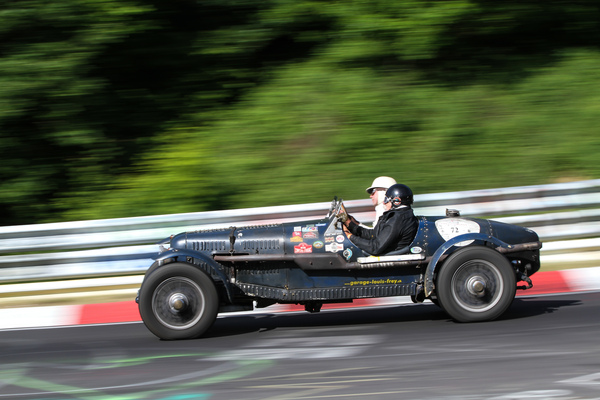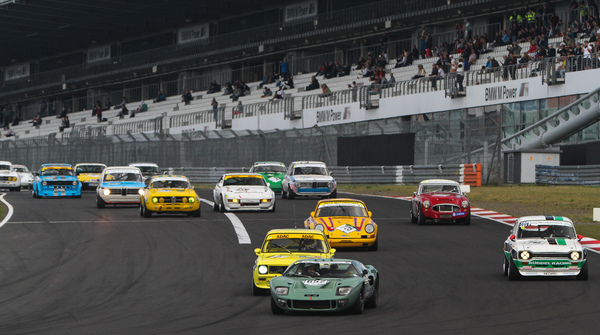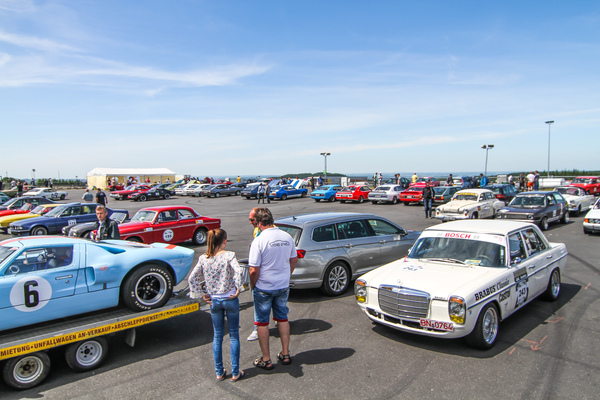From June 5 to 7, 2015, thousands of racing enthusiasts once again made the pilgrimage to the Eifel to attend the Historic Trophy Nürburgring. Many racing series for classic cars and motorcycles provided plenty of entertainment and the typical Nürburgring groove.
Separate races in typical weather conditions
The Eifel region in western Germany is used to changeable weather and so it was blisteringly hot on Friday, while on Saturday morning the participants had to contend with dense fog and cool temperatures, only to get used to warmer weather and sunshine again in the afternoon, which also made the Eifel region happy again on Sunday.
While the circuit sprint races and most of the GLP stages were organized as usual on the 4.5 km long Grand Prix circuit, some of the regularity runs took place on the 20.8 km long Nordschleife, and the endurance race even took place on a combination of the two track sections.
Herbert Linge Cup with potential
The series created in honor of Porsche veteran Herbert Linge was part of the Historic Trophy program for the second time this year. The special feature of this series is that only Porsche vehicles, i.e. 356, 912, early 911 and Porsche sports and prototypes, are eligible to take part. The race was a one-hour regularity test with driver changes and a compulsory pit stop.
An armada of 356s was on display, which certainly had something to do with the fact that the 356 Club was co-organizer of the event. In addition to a few 911s, there were also a few other Porsche sports cars on display. Unfortunately, there were no prototypes or special features of the Porsche brand, of which there were quite a few and which would have made the race even more interesting from a spectator's point of view. The drivers, however, were enthusiastic and felt exceptionally comfortable at the Nürburgring in their mostly comfortably motorized sports cars.
The well-known racing driver and namesake Herbert Linge was on site himself and commented on the race from the announcer's booth and attended the trophy presentation.
A battle of the dwarves worth seeing
The "Battle of the Dwarves" racing series of powerfully motorized small cars from German, English, French and Italian production is always an exciting experience, and not just for dwarf lovers and fans. Once again, exciting racing with thrilling duels was on offer here. The race lasted 30 minutes and Stefan Schmelter and Lutz Gerstdorf, who both drove the fourth round of the KdZ series at the Nürburgring in an NSU TT, also took part.
In conversation, the two TT drivers said that races at the Nürburgring are not so challenging for them, as the Grand Prix circuit simply requires a lot of power. As a result, it was once again difficult this year to finish in the top ranks with an NSU, as the best NSUs had around 110 hp, while the Minis (due to a different set of regulations) easily produced 130 hp, despite being lighter. "But we still had fun driving," said the grinning NSU drivers.
And so, in the end, a Mini driver came out on top, with Thomas Klingelhöfer receiving the winner's trophy. Christoph and Michael Wilde in the Simca Rallye 2 came in second, third place went to another Mini and the first NSU TT followed in fifth place.
Touring car revival
Since 2009, the touring car revival has also been part of the "Trophy" program. Here, cars from the DRM and the DTM up to the year 2000 return to the track. This year, the field of vehicles was significantly smaller and less varied. In addition to the real racing cars, including former cars from Cecotto, Ludwig and Lohr, there were replicas and replicas at the start.
In terms of sound and memories of exciting touring car races, the revival still offered good entertainment.
Formula racing for the little ones
In the Formula Vau and Super Vau, the drivers were spirited and fought for positions with zeal. The small formula cars, which were once built on small budgets, still inspire today.
At the AvD Historic Race Cup, fans of formula racing found their favorites again, starting with Formula Junior. The Histo Cup also featured only single-seater racing cars.
Old on old
It was hard to resist the fascination of the roaring pre-war vehicles. At the FHR Vintage Nürburgring, the cars built between 1900 and 1940 were on the grid and gave goosebumps all around the Nordschleife. Seeing the old powerhouses on a track from 1927 - the Nürburgring was inaugurated on June 18, 1927 - was somehow fitting and almost age-appropriate.

Elegant Gran Turismo
Of course, historic racing is not about beauty. However, the vehicles in the FHR HTGT series would certainly have had the chance to win beauty awards. The Chevron B16s in particular, which are represented in large numbers, combine efficiency and elegance in the best possible way.
Max-Gerrit Westhoff drove his sports car with starting number 240 to first place, followed by a wonderfully brute Chevrolet Corvette C3 in Le Mans livery, driven by Wolfgang Schachlinger. Dieter Lehner from Switzerland put his Shelby Mustang GT 350 in third place and completed the DACH tercet.
Modern series included
This year, some more modern series were included. For example, the Porsche Club Historic Challenge (PCHC), which has been running as an international racing series for the Porsche Club Deutschland since 2014 and in which more modern vehicles predominate. In terms of sound and appearance, however, this was certainly attractive and many a spectator was probably pleased with this addition to the program.
The Hankook Cup and the Touring Car Trophy also belong to the more modern series and attracted many participants to the Eifel.
Accidents and fog cause delays
Thick fog on Saturday morning meant that some races, e.g. the first race in the Battle of the Dwarves, had to be aborted as visibility was too limited. The drivers also reported that they could barely see their hands in front of their eyes at times. The timed practice for the endurance race also had to be aborted on the first lap. Unfortunately, these interruptions and delays threw the entire schedule into disarray on Saturday.
A serious accident involving the motorcycle sidecars in the evening also caused disruptions when a team skidded violently due to oil on the track, injuring both driver and co-driver.
Unfortunately, Sunday was not spared accidents either, with a vehicle in the HTGT ending up on its roof in the very tight NGK chicane. This again led to delays.
Nordschleife provided excitement as always
One of the highlights of the weekend was, of course, the endurance race around the extended Nordschleife. As always, the 25 km or so made for different weather conditions. While it was beautiful and sunny in one place, fog restricted visibility on other parts of the route or the road was even wet. From a spectator's point of view, however, such a long track also has disadvantages, as the field of racing cars spreads out considerably. However, the Nordschleife offers, like hardly any other race track, great spectator points, so to speak, where you can really see how well a car is positioned and how optimally a racing driver masters the track. The endurance race, which offered plenty of opportunity for these observations, was also very popular in 2015.

The Youngtimer Trophy and the FHR Endurance Cup were contested. In terms of numbers, the "youngsters" predominated in the starting field and Porsche showed an impressive presence as a brand.
The fast Ford GT40 with Jason Wright and Andrew Wolfe at the wheel ultimately won the "old-timers" category, while the Youngtimer Trophy was won by Michael Schrey in a Porsche 935 K1, who completed 18 laps in three hours, covering the 25 km route in around 10 minutes on average.
A splash of color in the fast youngtimer field dominated by BMW and Porsche was the Opel Ascona 400, which finished in 6th place, with another Opel, the Ascona A, in 13th place.
Among the older vehicles, an Alfa Romeo 1900 limousine was a wonderful sight, which is not often seen at historic races in our part of the world.
The fate of André Sommerberg, who was able to start from pole position in his Youngtimer BMW 530, but had to retire on the fifth lap with a technical defect - a broken rocker arm - even though he was already in the top 30. His car, originally built according to Group 1, was converted for the Youngtimer Trophy at a reasonable cost and features a four-speed gearbox, which BMW had commissioned especially for this vehicle at the time. "First gear goes up to 100 km/h," smiled driver André Sommerberg, who is on the road with Sabine Schmitz's brother.
Little that was new at this year's Historic Trophy
Overall, the Historic Trophy presented a largely familiar basic program from other years, offering a colourful field of vehicles, but without any real highlights or special features. The weather was changeable, but for the most part pleasant, the races were sometimes more interesting, sometimes less exciting, but from time to time one would have wished for a little more program, excitement and variety.

There were hardly any spectators on Friday, but on Saturday it was particularly crowded and a lot of spectators were also present at the Nordschleife. The paddock was well attended and there was a small area for one-make clubs in the paddock, with GLP races on Friday and Sunday.

Overall, the line-up was reminiscent of the Preis der Stadt Stuttgart in Hockenheim, but that didn't bother anyone. There was plenty to enjoy and the charm of the Nordschleife is hard to resist anyway ... as the more than 300 pictures in the six photo galleries published with this article impressively show.



























































































































































































































